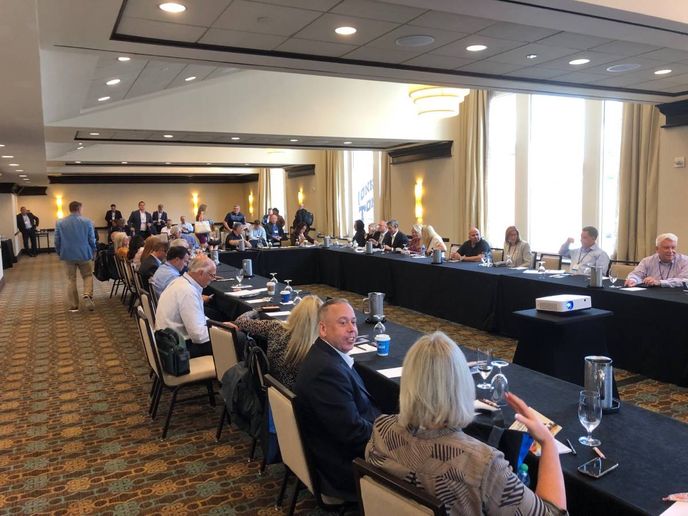
The IARA Summer Roundtable hosted meetings of all its standing committees on Aug. 17, 2022 in Nashville, Tennessee, to discuss a wide array of remarketing industry topics, including the valuation and handling of used electric vehicles.
Photo: Martin Romjue / Bobit
Roundtables aren’t just meant to be talked over, but can be loaded up with issues and agendas, like a convoy of casseroles difficult to digest.
At the International Automotive Remarketers annual Summer Roundtable Aug. 17, its Industry Advancement Committee, tasked with overseeing standards, technology, and electric vehicle policies, raised a list of questions that could fuel plenty of future discussions and spur the guidelines needed for consignors and auctions to recondition and resell electric fleet vehicles.
As the global electric vehicle market expands, the sector on track to be among first mass early adopters is fleet transportation, given its more controlled and predictable usage and duty cycles.
The committee announced it has a foundation for taking on EVs: It’s come up with a glossary of EV terms that members can commonly refer to and it has formed a working relationship with the National Auto Auction Association on developing remarketing standards for used electric vehicles. Those would include assessing battery life and installing charging infrastructure.
Committee member Venkat Krishnamoorthy, the CEO of AutoIMS, said the committee wants to focus on the logistics and transportation aspects of EVs, in getting them to and from auctions, dealers and customers. The committee seeks diverse representation among the many professional and vocational roles within remarketing that touch on EVs, he said.
Participants seated along a packed “square set” committee roundtable soon delved into a ricocheting discussion about all-electric vehicles that drew out mounting challenges and concerns:
- How will heavier electric vehicles affect the weight capacities of transport trucks and vehicles and affect decisions on what vehicles to use?
- Will new load distributions increase damage risks to EVs and the trucks carrying them?
- Will the auto transport industry need newer, larger truck models that can handle the heavier EVs, and how would heavier trucks affect the weight capacities of roadways?
- Will trailers be big enough to handle wider, heavier EVs? How do you prevent drivers from jamming in EVs with conventional vehicles to
- What is the risk of damage to the undercarriage of an electric vehicles, and what if the battery is positioned there? Does minor damage result in the totaling of the car?
- What are the fire risks given that EV battery fires can burn for hours before being extinguished with sediments in addition to water?
- And would that raise insurance compensation limits in the event of catastrophic transport truck fire loaded with EVs?
- How do weight and safety questions affect insurance policy and liability calculations overall, and will new policies with higher rates be needed?
- Will auto transporters have to raise their rates to maintain margins?
- When the EVs are dead and won’t start, will a jump pack work? What equipment needs to be installed on a transport truck to start an EV?
- How do consignors, auctions, and captive finance companies coordinate with repo operations to successfully retrieve and transport EVs?
- Will there be new competitive opportunities for transport companies that specialize in EVs and who can charge higher rates?
- How do you set up the support structure to educate all industry workers involved in handling and assessing EVs, including transporters, technicians, mechanics, drivers, condition report writers, lenders, financers, floor managers, etc.?
- How do you reconcile the practices and standards of asset-based carriers with those of broker-haulers who don’t use same equipment?
- How do you establish the consistent auction standards to handle what happens when an EV out of its first lifecycle beyond warranty goes through auctions a second or third time?
- What are the risks for underwriting an electric vehicle?
- Do you repair EVs at auctions or specialized third party services?
- What are wholesale buyers expecting on EV purchasing and transition costs? Do you put in the cost for certain repairs to make an EV more sellable?
- What will be the buyer pool for end-of-life EVs? Do foreign countries have same capabilities to handle them?
“There are so many variables, and we are all still learning,” said committee member John Mathiowetz, who has started a blog-podcast series on EVs from a remarketing angle. “There are so many considerations we have to factor in.”
As the roundtable ran out the clock, IARA President Jeff Bescher summed up the discussion as a series of “rabbit holes” worthy of much deeper inquiry and examination.
Originally posted on Vehicle Remarketing
